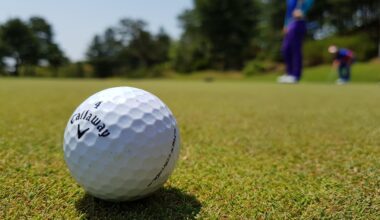Importance of Flexibility and Mobility in Injury Prevention
Flexibility and mobility are essential components of athletic performance and overall health. In sports medicine, it is widely recognized that improved flexibility decreases the risk of injuries during both training and competition. When athletes possess improved flexibility, they can achieve greater ranges of motion in their joints, which allows for optimal movement mechanics. This not only enhances performance but also safeguards against strains, sprains, and other injuries that could sideline an athlete for significant periods. Moreover, flexibility supports muscle recovery after workouts, allowing lactic acid to dissipate more effectively and reducing soreness. If athletes focus on incorporating stretching routines and mobility drills into their daily training regimens, they will benefit from reduced muscle tension and enhanced recovery. The incorporation of activities such as yoga and dynamic stretching has been shown to further cultivate flexibility and mobility, adding variety to training programs. Coaches and trainers should prioritize these elements as integral aspects of conditioning programs to ensure athletes can train effectively and remain injury-free. Consequently, investing time in flexibility training pays off in both athletic performance and injury prevention.
The Science Behind Flexibility
In understanding flexibility, it is crucial to delve into how muscles and connective tissues respond to stretching. Flexible muscles and connective tissues can elongate properly, accommodating a wider range of motion. A primary factor in flexibility is the elasticity of muscle fibers and the presence of collagen in connective tissues. When these tissues are subjected to regular stretching or mobility work, they become accustomed to the elongation and can withstand greater forces during athletic activity. Additionally, factors such as age, temperature, and genetics play significant roles in an individual’s baseline flexibility levels. Regular stretching improves blood flow to muscles, enabling better nutrient delivery and waste removal. Enhanced circulation can also help warm up the muscles, making them more pliable during activity, which can further prevent injuries. Furthermore, it has been demonstrated that regular flexibility training can positively impact overall muscle strength and endurance. To reap the benefits of improved flexibility, athletes should consistently incorporate a variety of stretching techniques into their pre- and post-exercise routines. This consistent approach not only helps prevent injuries but also contributes to better athletic performance.
Flexibility training should encompass a blend of static, dynamic, and proprioceptive neuromuscular facilitation (PNF) stretching to achieve optimal outcomes. Static stretching involves holding stretches for an extended period, promoting elongation of the muscles and increasing overall flexibility. Dynamic stretching, on the other hand, involves engaging in active movements that take joints through their full range of motion, making it particularly beneficial prior to athletic activity. This type of stretching prepares the muscles for action while increasing blood flow and reducing stiffness. PNF stretching incorporates both stretching and contracting of the targeted muscle groups, and it has shown to be one of the most effective methods for improving flexibility. Athletes often incorporate these methods before practices and competitions, as each aspect plays a role in enhancing performance. A strategic approach incorporating all three types of stretching will yield optimal results in flexibility improvements. Coaches and fitness professionals need to emphasize proper techniques to ensure that athletes avoid injury during stretching exercises. Consistency in these practices will not only enhance flexibility but also help in improving mobility and overall athletic performance.
The Role of Mobility in Performance
Mobility, frequently interchanged with flexibility, encompasses a broader range of functional movements. Mobility specifically refers to the ability of joints to move freely and efficiently through their complete range of motion during various movements. While flexibility deals with the length and elasticity of muscles, mobility also considers strength and control within that range of motion. When athletes possess functional mobility, they can execute complex movements more efficiently, resulting in enhanced performance. For instance, a gymnast’s ability to perform a split requires exceptional flexibility, but their capability to transition between movements seamlessly relies on mobility. Improving mobility also plays a critical role in reducing injury risks, as it ensures that joints can withstand the stresses of sports. Tight or immobile areas of the body can lead to compensatory movements, increasing the chance of injury. Therefore, a comprehensive training program should prioritize exercises that promote mobility, particularly in joints such as the hips, shoulders, and ankles. The integration of mobility training can significantly contribute to an athlete’s success and longevity in their sport, directly impacting their injury prevention endeavors.
To effectively enhance mobility, athletes can engage in a variety of targeted exercises designed to promote joint health and function. Activities such as foam rolling, yoga, and targeted strength training can serve to both increase flexibility and improve mobility. Foam rolling aids in myofascial release, loosening tight muscles and allowing for improved movement quality. Yoga, by nature, incorporates the essential elements of strength, flexibility, and balance; thus, it can facilitate improved mobility in a holistic manner. Additionally, strength training exercises focusing on mobility, such as squats and lunges, are crucial for teaching the body to control movements throughout full ranges of motion. Selecting exercises that emphasize proper mechanics and activate fundamental movement patterns increases the potential for improvements in mobility and overall performance. Coaches can guide athletes in developing personalized mobility routines based on their unique needs and specific sports. The ability to execute movements with coordination and strength while maintaining flexibility ultimately plays a significant role in reaching peak athletic performance and ensuring durability throughout an athlete’s career.
Incorporating Flexibility and Mobility into Training
To harness the benefits of both flexibility and mobility, athletes and coaches should create a structured plan integrating stretching and mobility exercises into daily routines. It is essential to establish flexibility and mobility training as a priority immediately after warm-ups and during cooldown sessions. Consistent practice will result in measurable improvements over time, thereby reducing injury risks and enhancing performance. Flexibility routines can be established as part of a general warm-up or specific pre-competition rituals. Equally important, mobility drills should be included to ensure both preparation and recovery are addressed. Implementing short mobility routines throughout training sessions keeps joints healthy while preventing stiffness that could lead to injury later. Maintaining an educational component can also be beneficial; athletes should understand how improved flexibility and mobility directly ties into their performance metrics. Various resources, including videos and infographics, can be utilized to highlight changes in flexibility and mobility levels. Adaptive strategies tailored to different sports can empower athletes, encouraging them to take ownership of their training regimens while fostering a culture that prioritizes health and longevity.
In conclusion, flexibility and mobility serve pivotal roles in injury prevention and athletic performance across various sports disciplines. Regular implementation of targeted practices designed to enhance these components will ensure athletes move efficiently and safely, thereby reducing the likelihood of injuries. Whether through systematic stretching routines, mobility drills, or the integration of techniques such as yoga, the evidence underscores the importance of prioritizing these elements within training programs. Coaches, trainers, and athletes alike must adopt a comprehensive approach to flexibility and mobility improvement, fostering better strategies that promote overall health and performance. By placing an emphasis on both flexibility and mobility, athletes can minimize their chances of incurring injuries while maximizing their potential. Ultimately, the time invested in stretching, mobility work, and education will yield tangible benefits, leading to longer, healthier sports careers and improved competitive outcomes. In the world of sports science and medicine, flexibility and mobility are not merely supplementary practices; they are foundational elements that everyone must incorporate into their training to optimize performance and longevity.
Wellness and injury prevention within sports medicine demand an appreciation for how flexibility and mobility intersect with various elements of physical health. Athletes should embrace this holistic perspective to enhance their performance, reduce injury risks, and contribute positively to their long-term health. By prioritizing flexibility and mobility as non-negotiable components of their training regimens, athletes open the door to greater accomplishments, longevity, and fulfillment in their sporting endeavors. Comprehensive training practices that include a well-rounded approach to flexibility and mobility will inevitably lead to superior athletic outcomes, serving as the cornerstone of a successful sports career. Coaches and athletes should collaborate in cultivating practices that allow for consistent flexibility and mobility development, ensuring that these essential skills remain a key focus in their training journeys. By committing to this foundation of flexibility and mobility, athletes empower themselves to reach their highest potential, maximizing their capabilities while safeguarding their bodies.


